
Backroads Around Las Vegas, Gold Butte National Monument

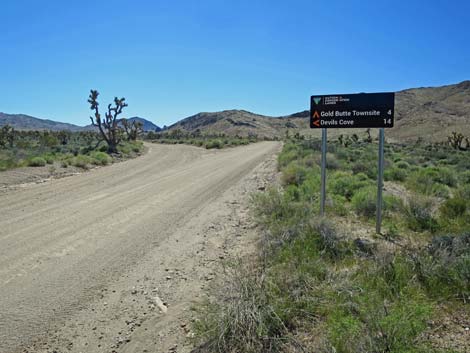 Gold Butte Road at Devils Cove Road (view SW) |
Current Conditions October 2023: the road is in standard condition and remains passable in 2WD-HC vehicles. Drivers -- please report your experience. |
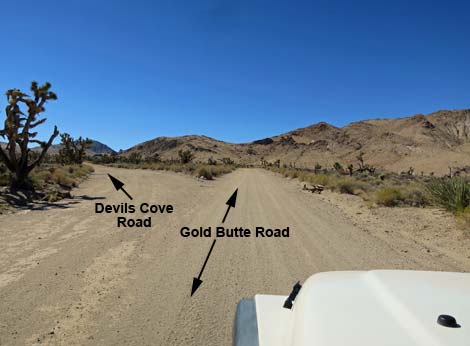 Gold Butte Road at Devils Cove Road (view SW) |
Overview Devils Cove Road is one of the major roads off Gold Butte Road that provides 2WD, high-clearance vehicle access to much of the wild and rugged Gold Butte National Monument mountains east of Gold Butte Townsite, but it requires 4WD to drive the full 14.5 miles to Devils Cove at the edge of Lake Mead. The road runs east into the mountains and climbs to Summit Pass, then descends nearly 3,000 feet heading south to Lake Mead. In a narrow, rocky canyon, the road was badly washed out some years ago, but is now passable in a 4WD vehicle without too much effort. There are several washouts and sandy areas to negotiate. Link to map or regional road map. |
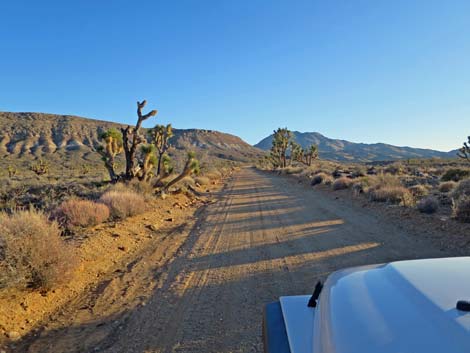 Starting on Devils Cove Road (view S) |
Watch Out Other than the standard warnings about hiking in the desert, ... this is a difficult 4WD road, but without any unusual hazards. This is wild and remote country without services of any kind (no restrooms, no water, no gas, no food). Bring what you need to survive. Be prepared and be self-reliant. It is a big place, but someone will eventually find you if you stay on a main road, but be prepared to survive alone for a day or two, or even longer on side roads. Cell phones don't work here. While out, please respect the land and the other people out there, and try to Leave No Trace of your passage. Also, this is a remote area, so be sure to bring the 10 Essentials. |
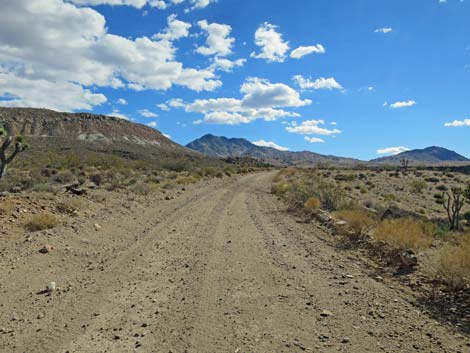 |
Getting to the Road Devils Cove Road is located out in Gold Butte National Monument northeast of Lake Mead, about 3 hours northeast of Las Vegas. From Las Vegas, drive out the paved Gold Butte Road to Whitney Pocket. Continue south on the unpaved Gold Butte Road for 16.5 miles to Devils Cove Road, a major fork to the left. |
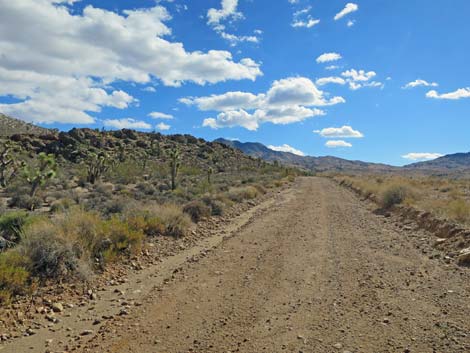 |
The Road From Gold Butte Road at Devils Cove Road (Table 1, Site 0797), the road angles away to the left heading south, eventually turning southeast as it angles around the south end of a towering limestone ridge. Passing the ridge about 1 mile out, side roads branch off both sides of Devils Cove Road, but the main road always is obvious. In this area, the road also enters the area burned in 2005 by the massive (82,000 acres) Fork Fire. Fortunately, not everything burned, and there are still patches of Singleleaf Pinyon Pine and Utah Juniper in the area. The road runs southeast as it climbs into the mountains. In a patch of forest that survived the fire (2.6 miles out), a spur road on the left leads to shady campsites. |
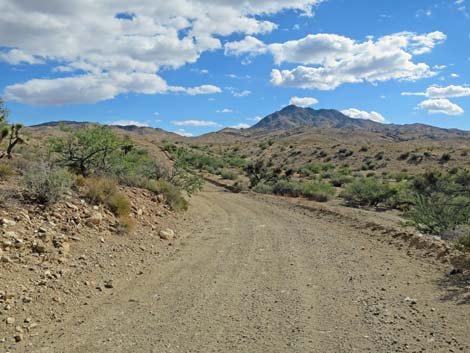 Devils Cove Road approaching Garden Spring Road (view SE) |
Devils Cove Road winds about as it climbs to a highpoint on a ridge with grand views to the northeast across northern Arizona. Descending steeply the other side of the ridge, the road drops into Immigrant Canyon and bends south. Crossing Immigrant Wash, the road passes Summit Spring Road (Site 1743), on the right, which leads a short distance to the trailhead for Summit Spring. The road continues up Immigrant Canyon, eventually running up onto Summit Pass (Site 1745), a site with great views north and south. Starting down towards Lake Mead, Devils Cove Road runs somewhat steeply down New Spring Wash, which is a fine driving road. The road eventually exits New Spring Wash to the right, more or less contouring across desert hillsides to cross a ridgeline near Connoly Spring. |
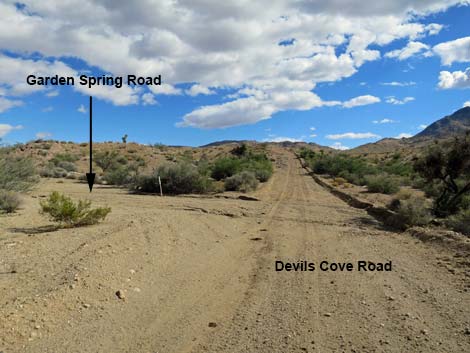 Devils Cove Road at Garden Spring Road (view SE) |
Beyond the ridgeline, Devils Cove Road begins to descend Connoly Wash. Shortly, the road passes Connoly Corral Road (Site 1746), a short spur road west that leads to the old Connoly Corral. Continuing, Devils Cove Road eventually exits the wash to the right, again more or less contouring across desert hillsides to the next ridgeline. Crossing this ridgeline, the road also crosses the boundary into Lake Mead National Recreation Area (Site 1748) and begins to descend towards Devils Cove on the edge of the lake. The road deteriorates rapidly beyond the park boundary as it runs down a steep, narrow, rocky canyon. This area flash flooded in 2005, and the road is worse for wear, but it is suitable for 4WD vehicles. From the park boundary, the worst of the road lies between 0.6 and 1.0 miles out. One steep spot is even covered in cement to cover rocks and improve traction. |
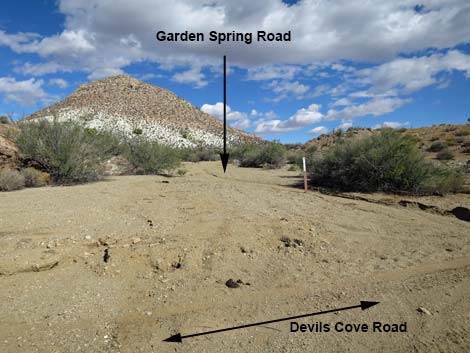 Garden Spring Road (view SE from Devils Cove Road) |
Near the bottom of the steep, narrow canyon, the road contours out to the left avoiding even steeper slopes below. The road eventually drops towards the bottom of the canyon, but now beyond the confluence with a much larger wash entering from the west, and from this point on, the road becomes more sandy than rocky. Immediately before getting to the wash (9.8 miles out), the road forks. The left, the old road, is hopelessly washed out in a few hundred yards, but the new road cuts across the sandy wash to the other side. The road runs in and out of the sandy wash, but generally is a fine 4WD road. |
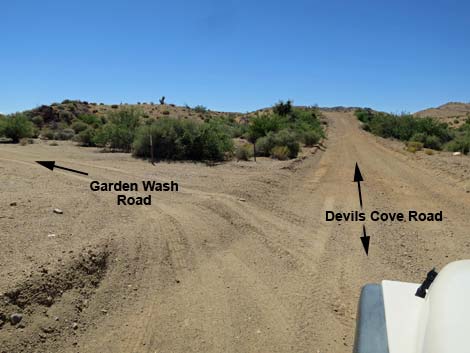 Devils Cove Road at Garden Spring Road (view SE) Devils Cove Road at Garden Spring Road (view SE) |
At about 11.7 miles out, Devils Cove Road passes Cottonwood Canyon Road (Site 1749), on the right. To the west, this short spur road leads to a trailhead and a nice hike up Cottonwood Canyon to near the edge of Jumbo Springs Wilderness Area. Continuing down Cottonwood Wash, Devils Cove Road becomes firm and smooth, a much nicer road than before. Eventually the road drops below the high-water mark of Lake Mead and ends at Devils Cove on the "current" edge of the lake (Site 1751). In 2013, trees had grown up on the lakeshore blocking views of the water and requiring visitors to hike out a bit (Devils Finger Route) to get a view of the Colorado River. Changing water level in Lake Mead will affect the exact position of the shoreline, so drivers should be careful to avoid deep and sticky muck when the edge is wet. |
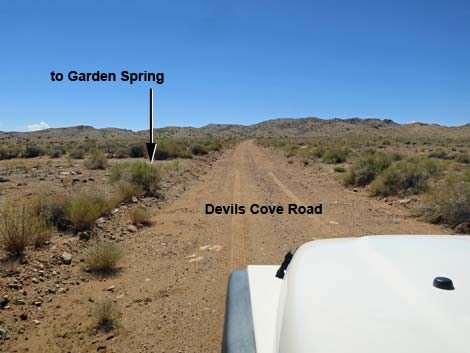 Devils Cove Road approaching 4-way intersection (view SE) |
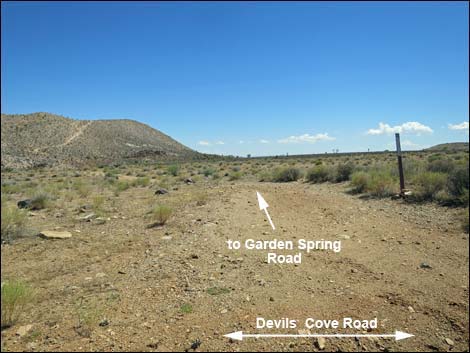 Garden Spring Alternate Road (view NE from Gold Butte Road) |
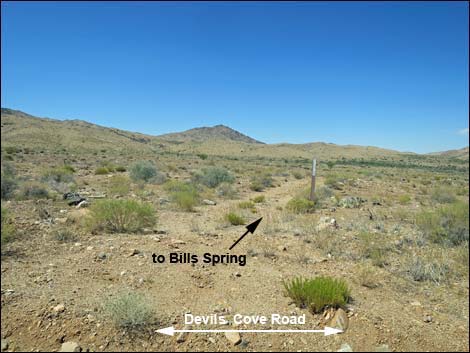 First road to Bills Spring
(view SW from
Gold Butte Road) First road to Bills Spring
(view SW from
Gold Butte Road) |
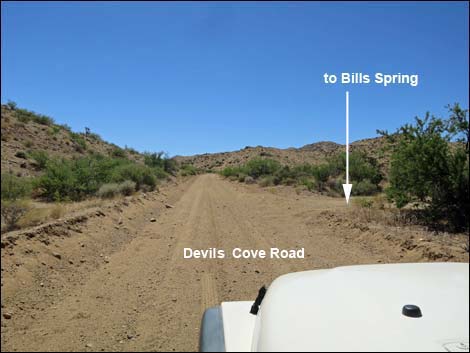 Gold Butte Road at second road to Bills Spring (view SE) |
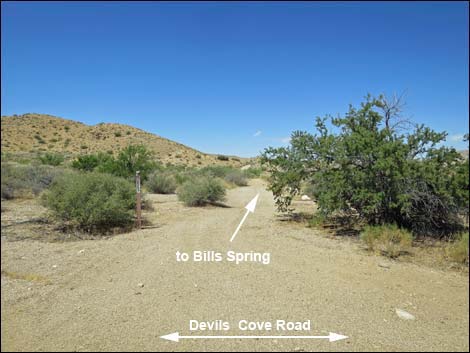 Second road to Bills Spring (view SE) |
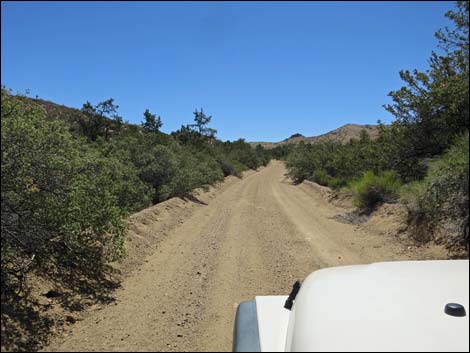 Road runs through unburned Pinyon-Juniper Forest (view NE) |
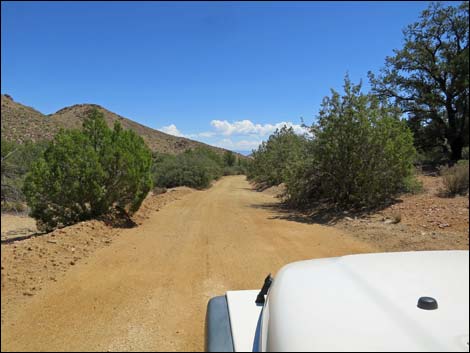 |
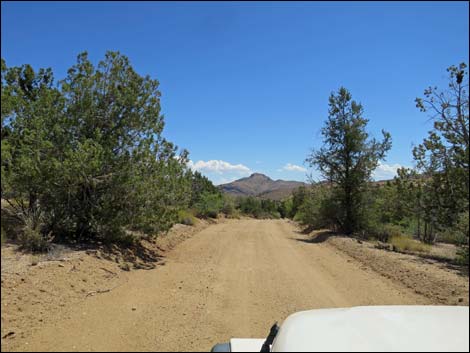 |
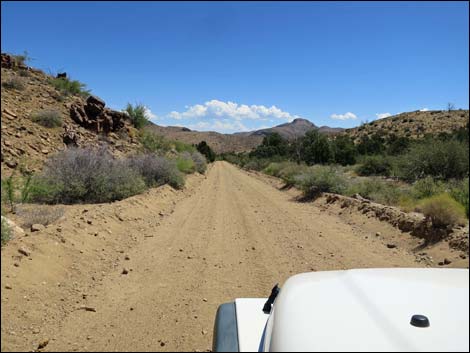 Road in Pinyon-Juniper Forest (view NE) |
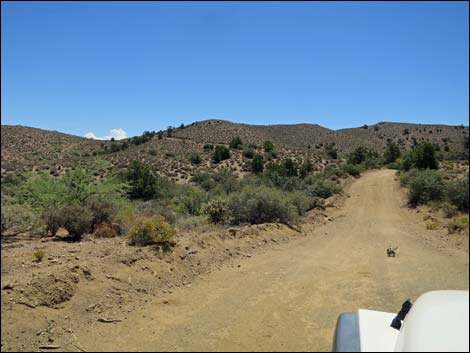 Devils Cove Road (view SE) |
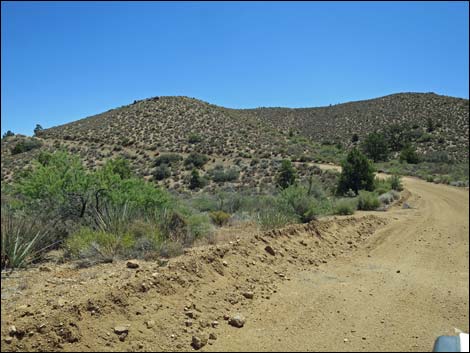 The road climbs into the hills (view SE) |
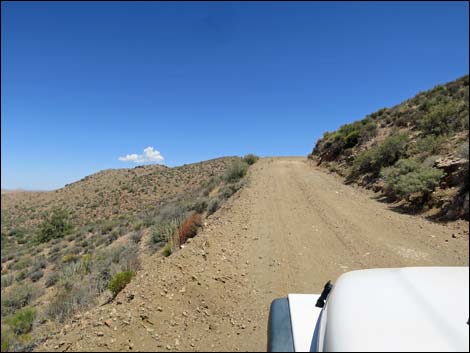 Some parts a steep (view E) |
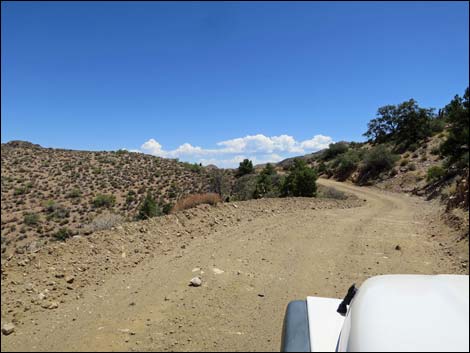 |
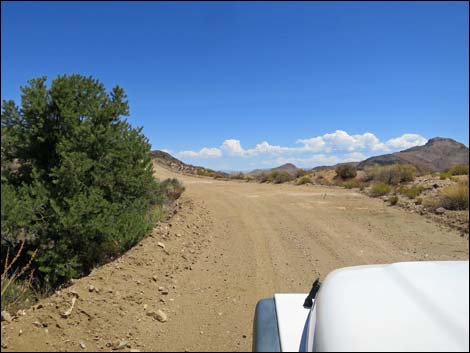 |
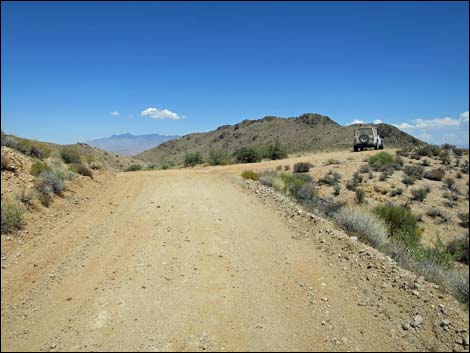 Pullout and overlook at the top of the hill (view SE) |
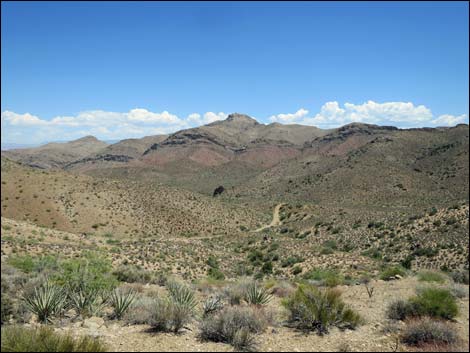 Grand scenery and the road ahead (view E from overlook) |
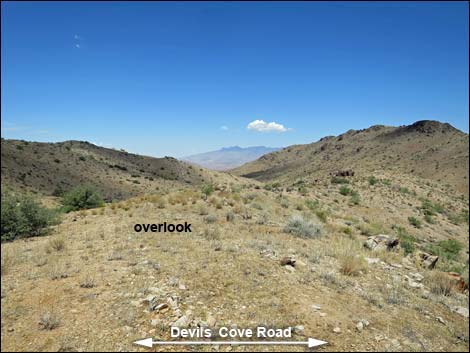 Grand scenery (view NE from overlook) |
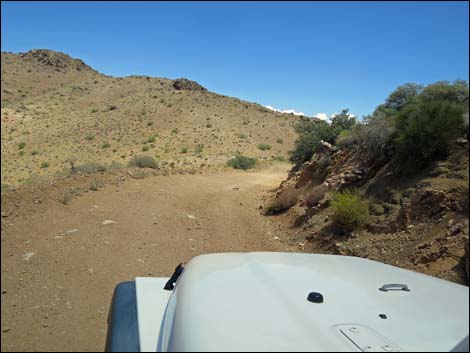 The road begins to descend steeply (view E) |
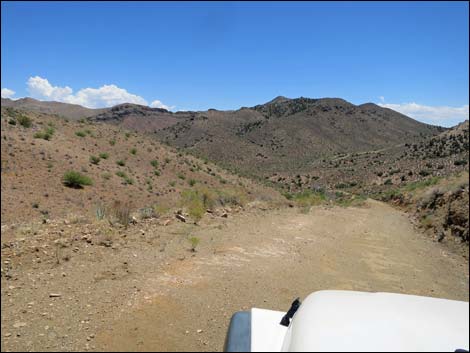 Descending steeply (view E) |
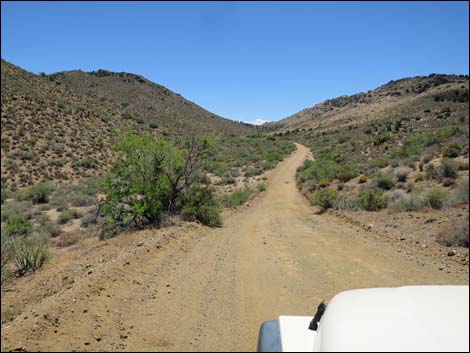 Approaching the bottom of the steep hill (view S) |
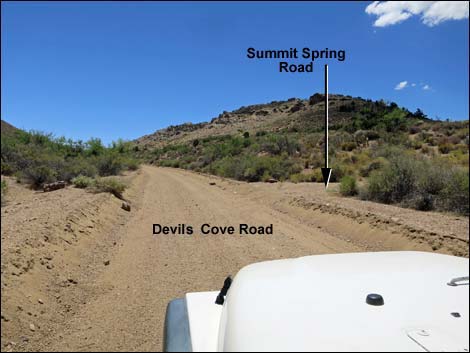 Devils Cove Road at Summit Spring Road (view S) |
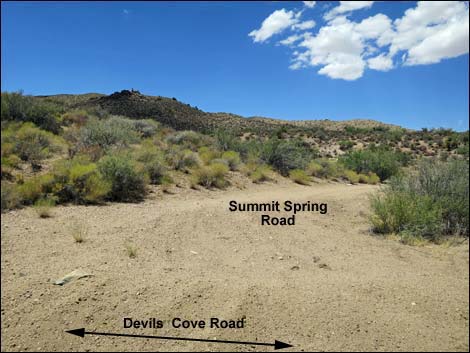 Summit Spring Road (view W from Devils Cove Road) |
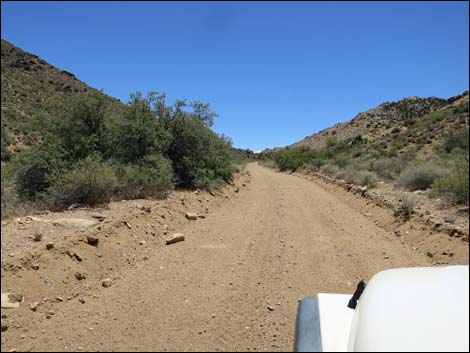 |
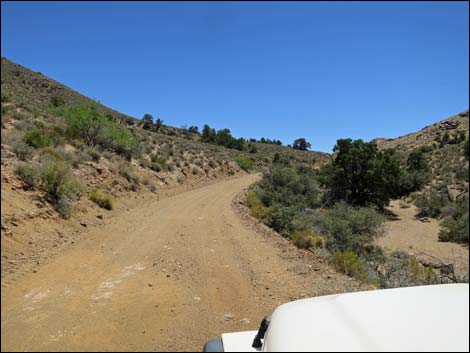 |
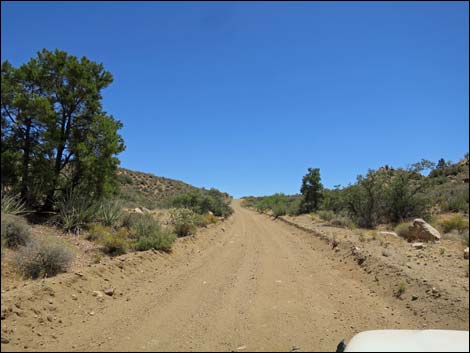 Devils Cove Road climbs towards Summit Pass (view S) |
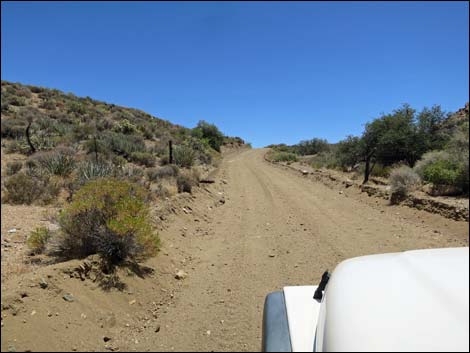 Devils Cove Road approaching Summit Pass (view S) |
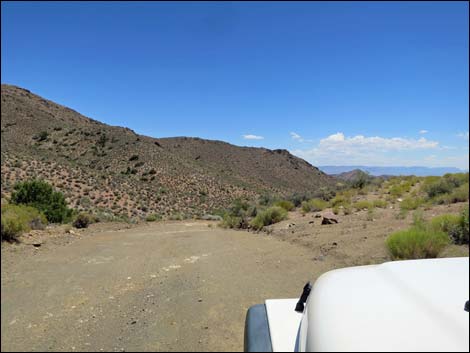 Devils Cove Road at Summit Pass (view S) |
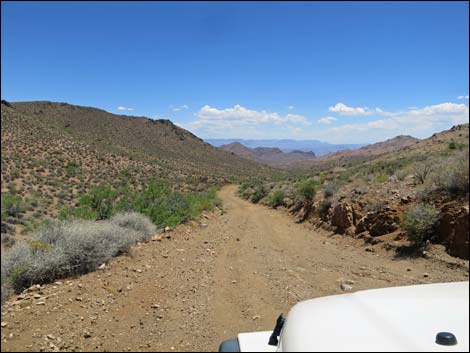 Continuing over Summit Pass (view S) |
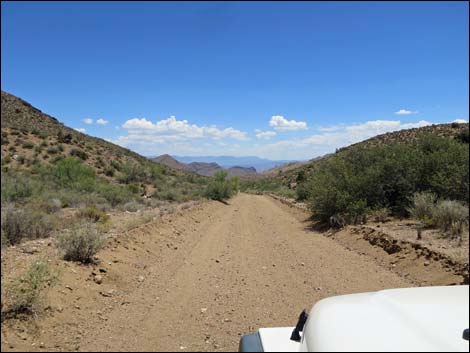 |
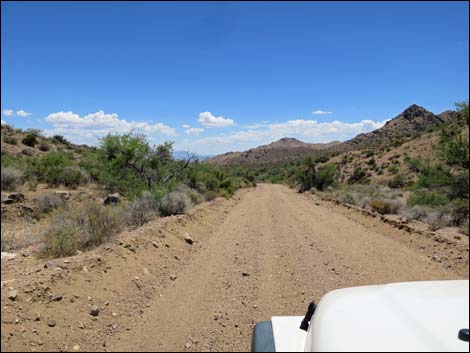 |
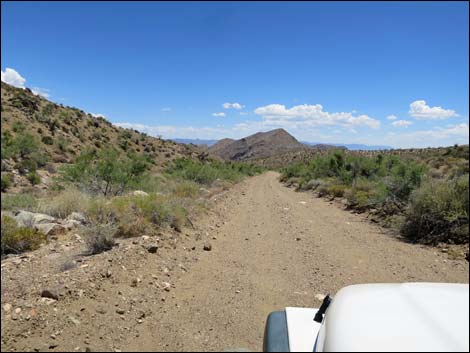 |
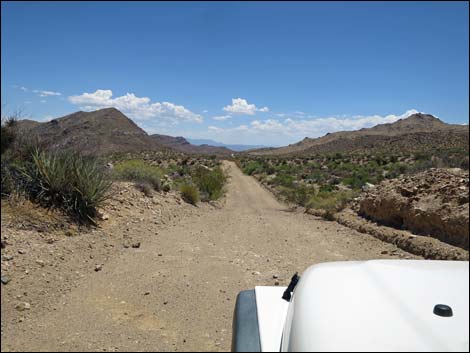 |
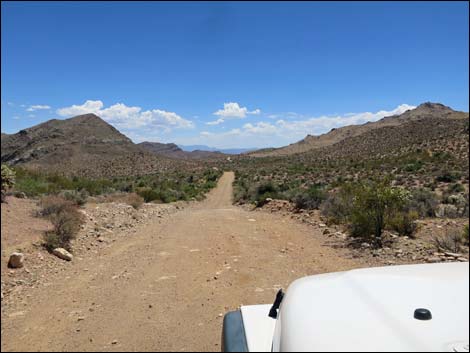 |
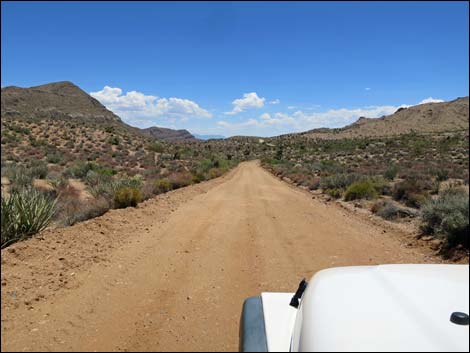 |
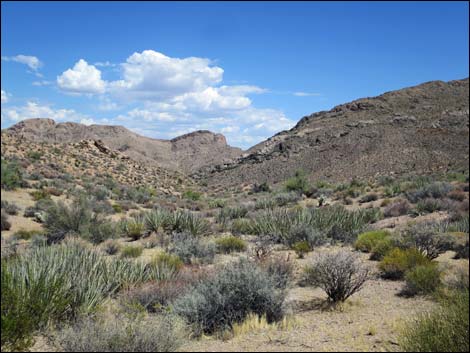 Grand scenery (view E) |
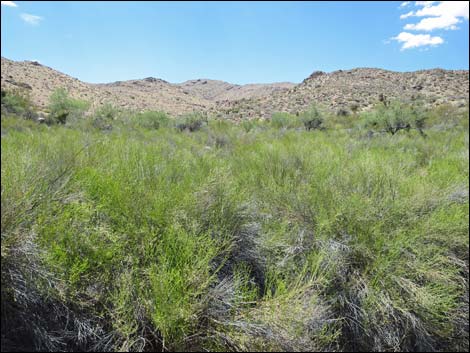 There must be a spring in there somewhere (view NW) |
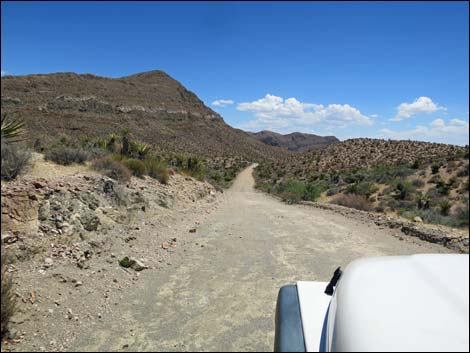 Devils Cove Road (view S) |
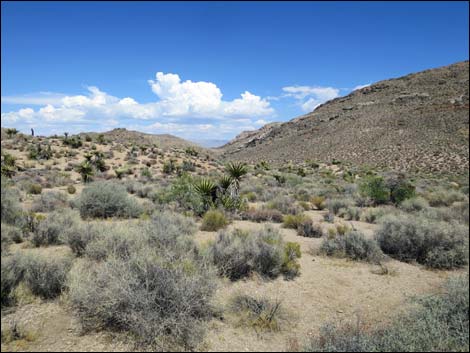 Grand scenery (view SE) |
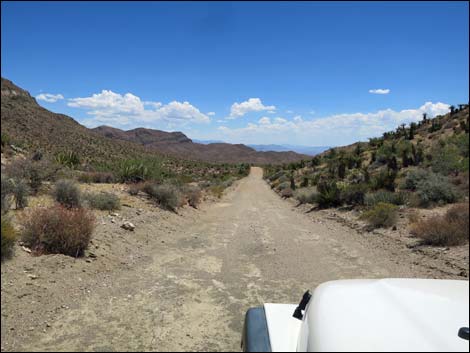 Devils Cove Road (view S) |
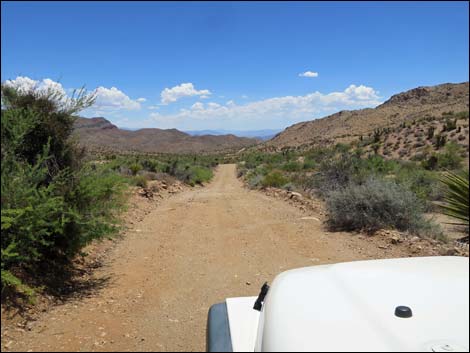 Devils Cove Road (view S) |
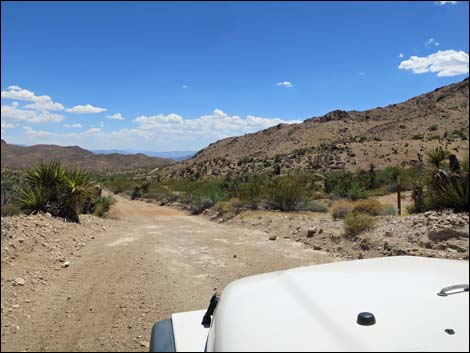 Devils Cove Road at first turn to Connoly Corral (view S) |
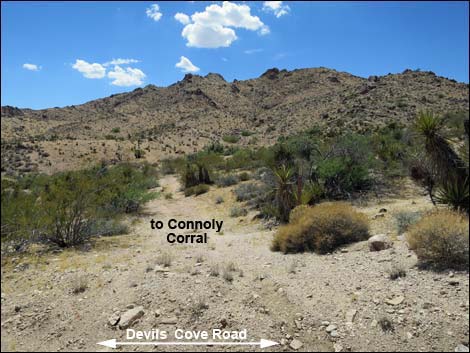 First access road to Connoly Corral (view S) |
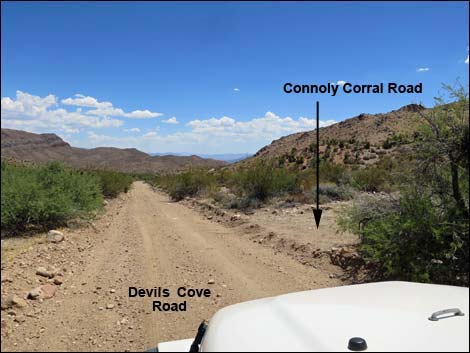 Devils Cove Road at second turn to Connoly Corral (view S) |
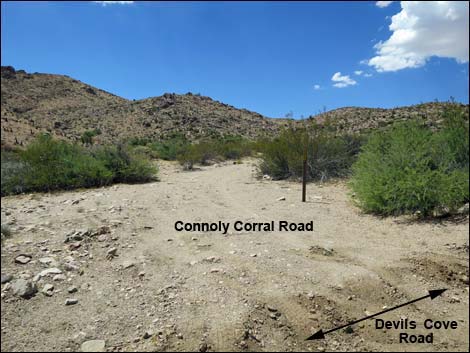 Second access road to Connoly Corral (view S) |
 Devils Cove Road (view S) |
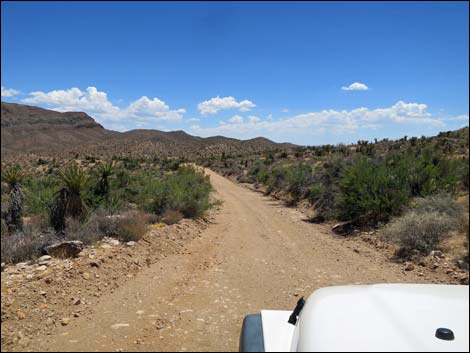 Devils Cove Road (view S) |
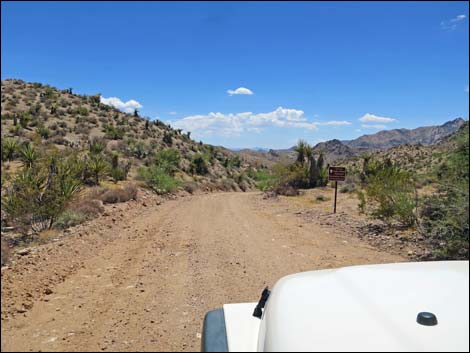 Lake Mead NRA boundary sign; near end of good road (view S) |
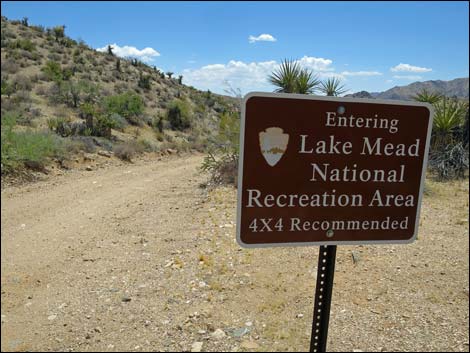 Lake Mead NRA boundary sign (view S) |
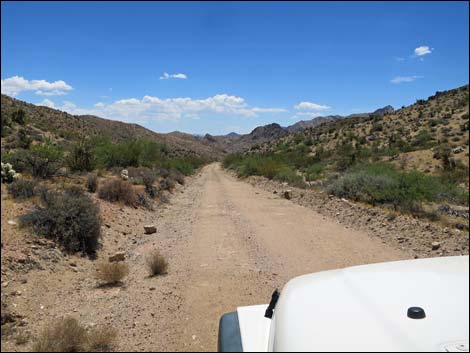 Devils Cove Road (view S) |
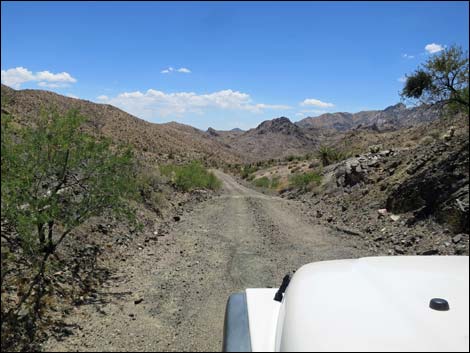 Devils Cove Road (view S) |
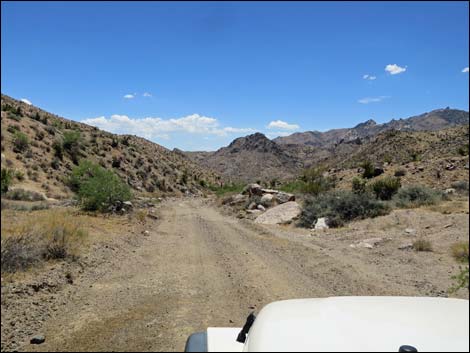 End of good road; grader turns around here (view S) |
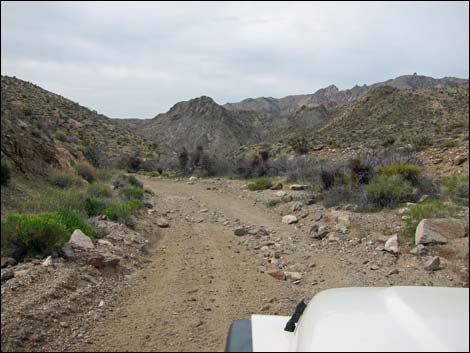 Road condition deteriorates (view S) |
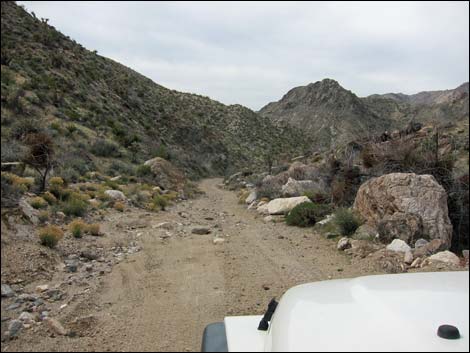 Rocky road (view S) |
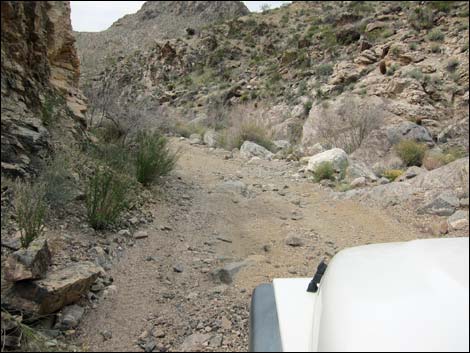 Rocky road (view S) |
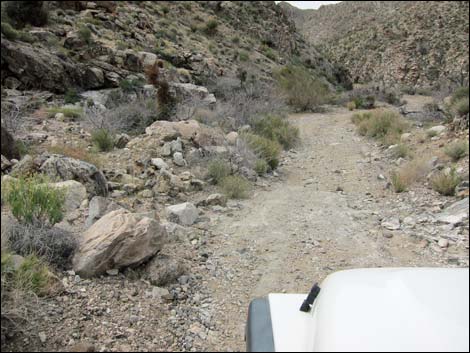 Steep road with concrete for traction (view S) |
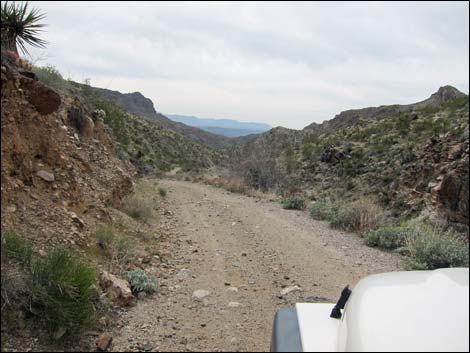 High on canyon wall, beyond the worst road conditions (view S) |
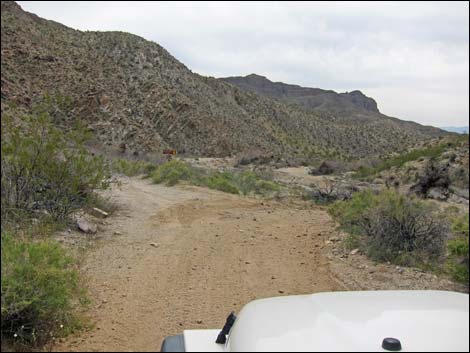 Washed out, new road stays right (view S) |
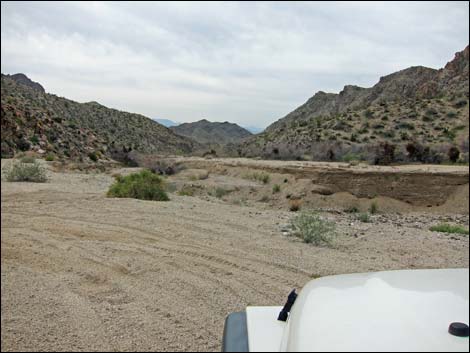 Deep sand (view S) |
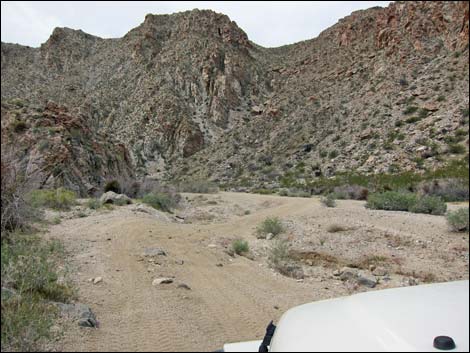 Road eventually climbs out of sandy wash (view S) |
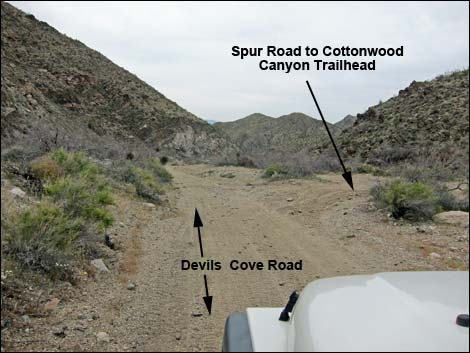 Devils Cove Road at Cottonwood Canyon Road |
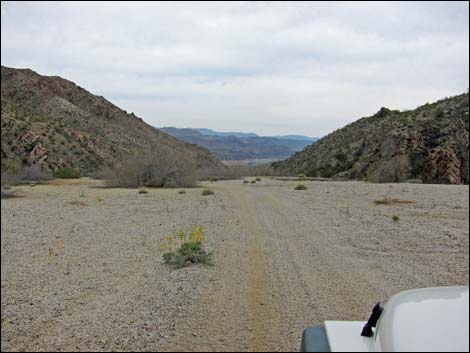 Lake Mead ahead in the distance (view S) |
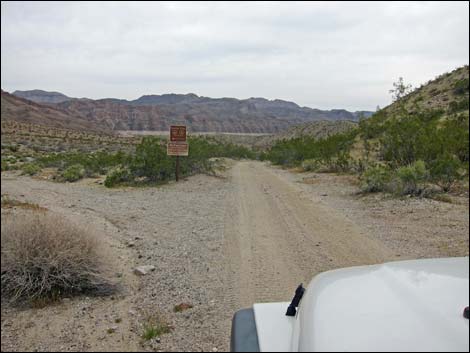 Approaching Devils Cove camping area sign (view S) |
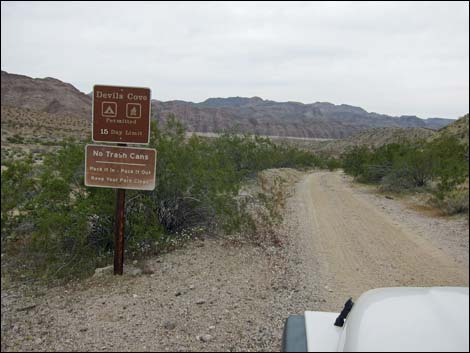 Devils Cove camping area sign (view S) |
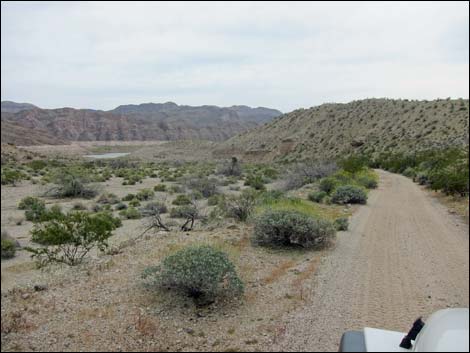 Easy road descending towards the cove (view S) |
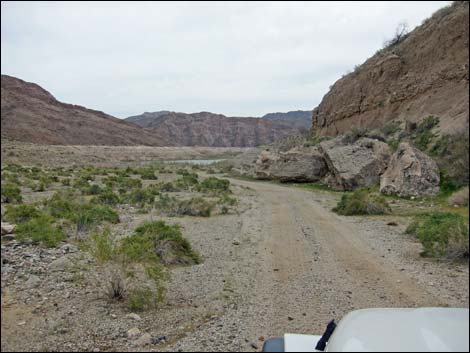 Passing below Lake Mead high-water mark (view S) |
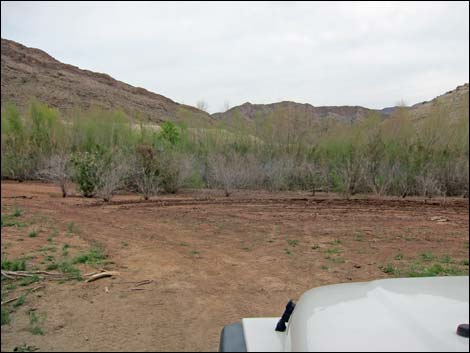 Arriving at 2013 water level (view S; blocked by ash trees) |
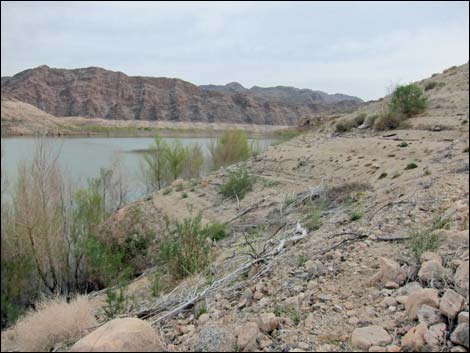 Devils Finger Route, the water is visible (view S) |
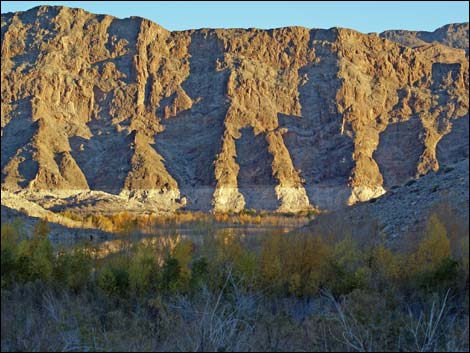 Devils Cove; Colorado River in the distance |
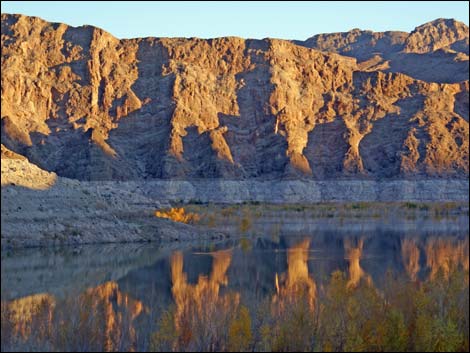 Devils Cove; Colorado River in the distance |
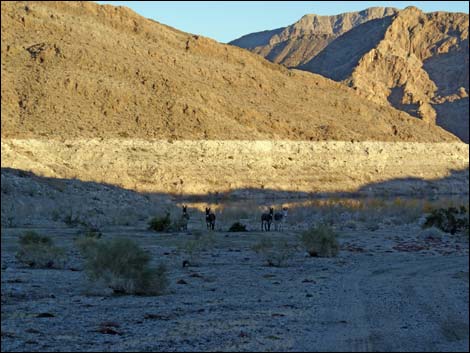 Feral burros at Devils Cove |
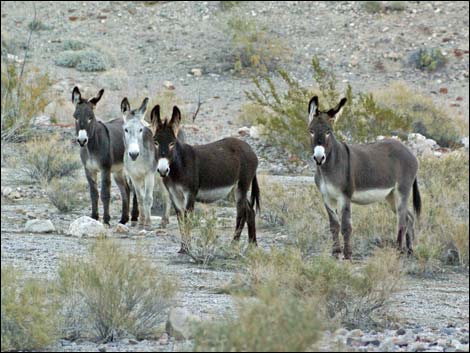 Meeting the locals |
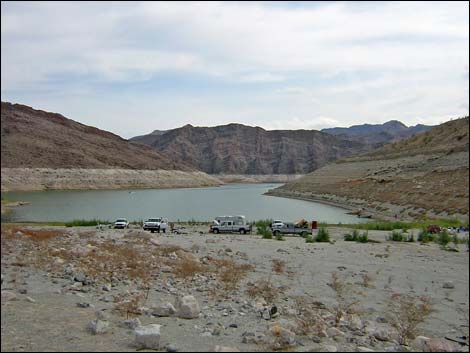 Devils Cove in 2003 before the road washed out |
Driving Back Out
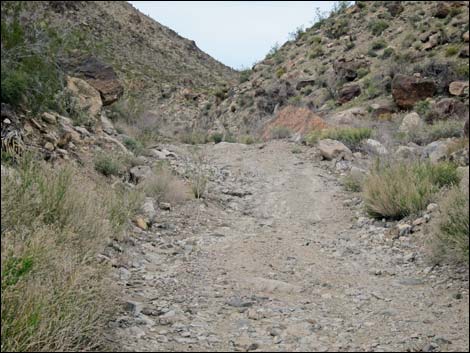 Steep road with concrete for traction (view N) |
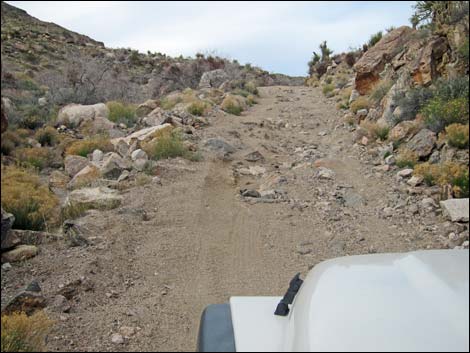 Steep road with rocks (view N) |
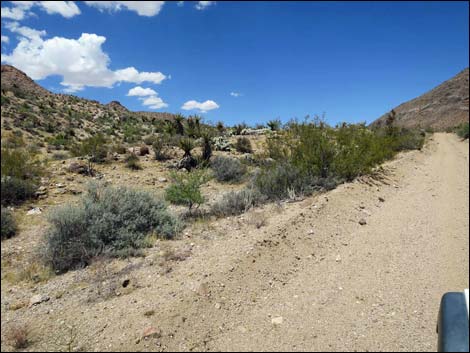 Back on the good road (view N) |
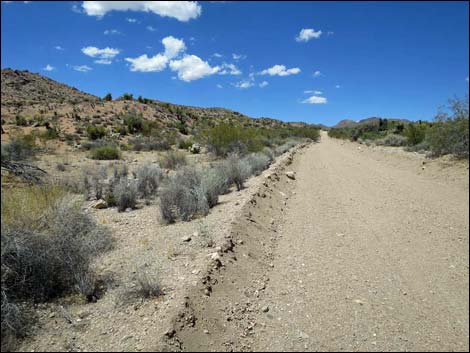 Devils Cove Road (view N) |
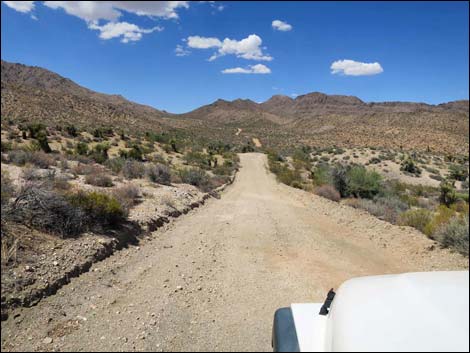 |
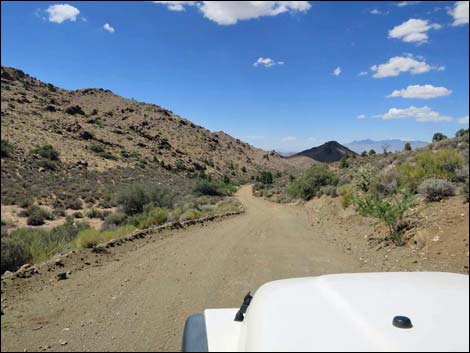 |
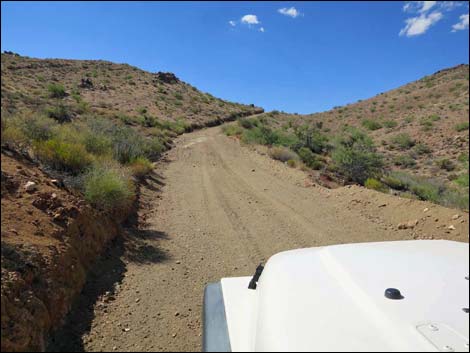 Starting up the steep hill (view N) |
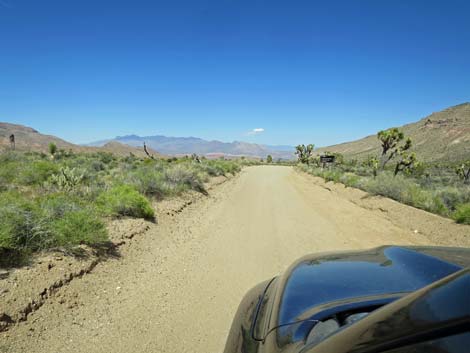 Devils Cove Road approaching Gold Butte Road (view N) |
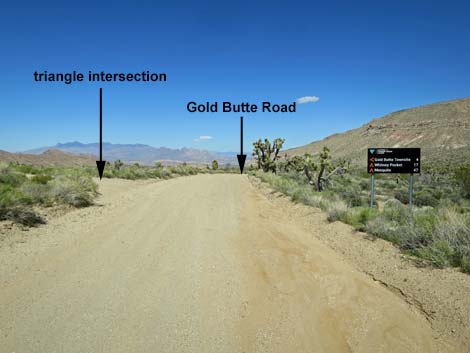 Devils Cove Road approaching Gold Butte Road (view N) |
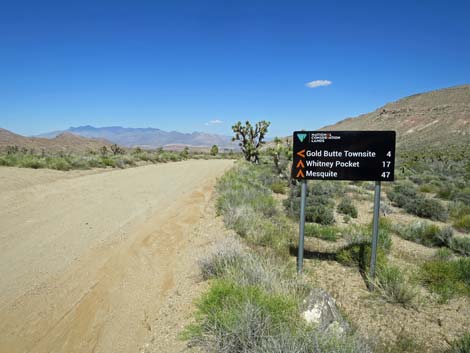 Devils Cove Road directional sign (view N) |
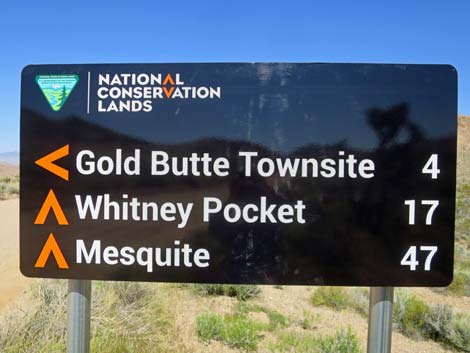 Devils Cove Road directional sign (view N) |
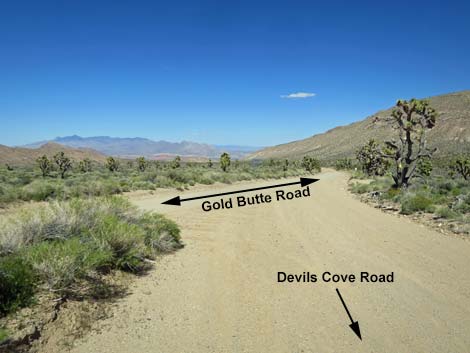 Devils Cove Road at Gold Butte Road (view N) |
Table 1. Highway Coordinates Based on GPS Data (NAD27; UTM Zone 11S). Download Highway GPS Waypoints (*.gpx) file.
| Wpt. | Location | Latitude (N) | Longitude (W) | Elevation (ft) | Point-to-Point Distance (mi) | Cumulative Distance (mi) | Verified |
|---|---|---|---|---|---|---|---|
| 0797 | Gold Butte Rd at Devils Cove Rd | 36.31315 | 114.15450 | 3,509 | 0.00 | 00.00 | Yes |
| 1743 | Devils Cove Rd at Summit Spring Rd | 36.28747 | 114.11323 | 3,761 | 4.28 | 04.28 | Yes |
| 1745 | Devils Cove Rd at Summit Pass | 36.27504 | 114.11220 | 4,095 | 0.88 | 05.16 | Yes |
| 1746 | Devils Cove Rd at Connoly Corral Rd | 36.24014 | 114.10367 | 3,342 | 2.55 | 07.71 | Yes |
| 1748 | Devils Cove Rd at Lake Mead Boundary | 36.23080 | 114.10533 | 3,209 | 0.66 | 08.37 | Yes |
| 1749 | Devils Cove Rd at Cottonwood Canyon | 36.18869 | 114.11770 | 1,940 | 3.36 | 11.73 | Yes |
| 1751 | Devils Cove Rd at Lake Mead | 36.15632 | 114.09702 | 1,141 | 2.73 | 14.46 | Yes |
Happy Hiking! All distances, elevations, and other facts are approximate.
![]() ; Last updated 240326
; Last updated 240326
| Backroads Around Las Vegas | Hiking Around Las Vegas | Glossary | Copyright, Conditions, Disclaimer | Home |